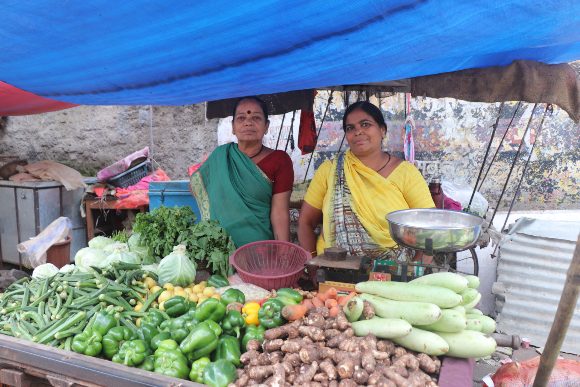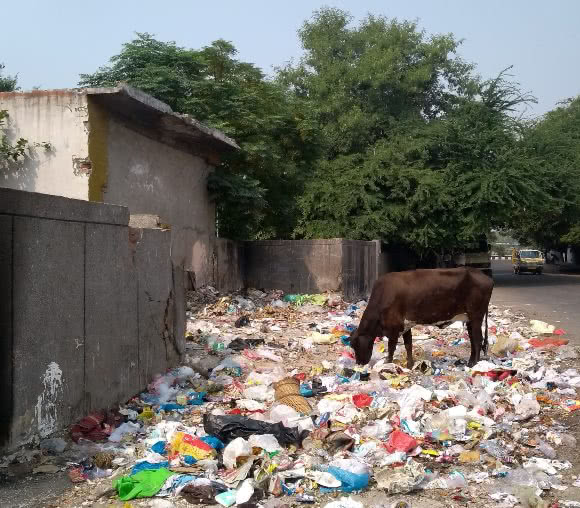Delhi Diary highlights reflections, insights and notes from the field from the Focal City Delhi (FCD) team in their ongoing work with informal workers. We capture these on a regular basis in order to provide a dynamic picture of the ways in which informal workers in Delhi are consistently struggling, resisting and innovating against great odds.

Street Vendors Act: Many roads to Implementation
By Avi Singh Majithia
Street vendors are an integral part of the informal economy in India. They are estimated to account for 14 per cent of all informal urban employment, and 4 per cent of the urban workforce across India. However, street vendors have historically faced numerous challenges, from evictions to harassment by authorities and the struggle for recognition was a long road, leading to a landmark law.
The Street Vendors (Protection of Livelihood and Regulation of Street Vending) Act 2014, which regulates street vending and hawking, is unique in its scope and progressive nature. The law aims to institutionalise street vendors’ participation in urban planning via Town Vending Committees (TVCs). If this law is implemented in the spirit intended, it can lead to major improvements in securing the livelihoods of street vendors and according them more dignity in their work.
Implementation, however, is only just beginning and is incomplete and insufficient. Additionally, with no uniform understanding of what implementation means, vendors are unclear on what can count as a victory in these times.
Recently, news broke that Delhi is set to become the first city to fully implement the Street Vendors Act, a claim that while unchallenged, raises questions on what implementation truly means.
In September 2018, Delhi constituted temporary TVCs to survey vendors in the city, and then to hold democratic elections to constitute long-term TVCs as required in the Act. However these TVCs were held back in their scope by the absence of a scheme laying down the rules and regulations to follow in implementing the Act. Due to the lack of sufficient vendor representation in many TVCs, fresh TVCs had to be constituted in September 2019. Then in October, the Delhi government also issued the scheme governing the functioning of TVCs. In this new context, it does look like Delhi is set to move forward on implementing the law.
However, other cities and states claim to have moved far ahead in terms of implementation. Chandigarh recently was in the news for being the first city to resettle street vendors in marked vending zones. Many other cities are also ahead of Delhi in the process.
How is Delhi’s claim of being first to be understood then?
According to Ankit Jha, a researcher-activist working with street vendors, Delhi can claim to be the only city implementing the law in letter and spirit. In other cities, TVCs have been nominated, whereas in Delhi, the entire process has attempted to be as consultative as possible.
Delhi is unique in instituting temporary TVCs to address the issue of vendor representation due to insufficient data on the actual number of vendors in the city. The scheme has also come after a period of consultation with vendor groups and is more progressive than its earlier iteration issued by the government in 2016.
These are all positive steps.
However, this process of consultation is taking place amidst widespread evictions, which are ramping up across the city. Though Delhi’s Chief Minister has assured that the survey process and issuance of licenses would be done before the end of year, that timeline is looking improbable. These TVCs are dogged by the same problems as their predecessors. Four months on, many TVCs have convened only once and the survey process is delayed and yet to begin.
In the course of this process, we have entered a new year and a new decade; one hopes that though delayed, Delhi can become a case study on what true implementation of the law will look like.
The Changing Waste Economy of Delhi and its Impact on Waste Pickers
By Avi Singh Majithia
In Delhi, the waste landscape is shifting rapidly. The way waste pickers can access waste, sort and even sell recyclables is fast-changing, and these changes are impacting their ability to earn an income.
Recently, FCD worked with Lokadhikar, a partner organisation that works on issues of waste picker livelihoods, to understand the impact of the dwindling number of segregation sites on waste picker livelihoods.
Dhalaos, which are open sorting centres, have long existed at the neighbourhood level. Waste pickers can sit inside the structure, sort waste and separate recyclables to later sell. The waste generated at home is dumped at the dhalao, from where the ULB is supposed to collect the waste to be transported to dumpsites. Before the waste is picked up, recyclables are salvaged by waste pickers from the dhalaos. FCD mapped the dhalaos present in one ward (Ward no. 57) in Rohini zone in North-west Delhi.
Using existing data from 2017 (Lokadhikar mapping of dhalaos), we noted that 11 dhalaos were present in this ward. Recent mapping by FCD shows that in the past 2 years, the number of dhalaos has greatly reduced and they have a different design that impacts segregation practices. By 2019, there were only 3 dhalaos in this ward. Two of these have been converted to a new design wherein a trash compactor is present in the dhalao.
Waste is being directly deposited into the compactor. The compactor effectively processes the incoming waste—and prevents the waste pickers from segregating recyclables from it. Even waste pickers who collect and bring waste on their own carts are being forced to feed waste directly into the compactor without segregation.
An important aspect of this change can be understood through the privatisation of solid waste management in the city. Earlier, municipal workers were only responsible for transporting waste from the dhalaos to dumpsites, after it had been segregated and recyclables had been set aside. Waste pickers were responsible for door-to-door collection of waste, as well as segregation. From this work, they derived their primary income.
Post privatisation, private company employees are also engaging in the collection of waste, reducing access to waste for informal waste pickers. Waste that has been traditionally understood to be a common property resource now seemingly is in control of private hands.

FCD’s case study shows that these changes have a direct impact on waste pickers:
- Privatisation has reduced waste pickers’ access to waste and recyclables.
- Waste pickers’ work has become more physically arduous. Due to a fall in the number of dhalaos, waste pickers have to travel 2-3 km to reach a dhalao, often making more than one trip to deposit all the collected waste.
- They now have less space to sort waste. Sometimes, this is just a small corner in the housing society itself which has to be constantly negotiated. Very often, this is not possible because of traditional complaints of bad smell and a lack of cleanliness. Many waste pickers, without any space, sort waste on the side of the road, which has led to an increase in harassment from police and municipal officials.
- The new dhalao design has greatly reduced the income waste pickers can earn.
- Compacting incoming waste has also led to a deterioration in the nature of waste going to the dumpsite and has the potential to negatively affect the environment.
Informal waste pickers have long played an important role in the city’s solid waste management system. By recycling, they prevent tonnes of waste going to landfills and increasing pollution in the city. The growing practice of compacting waste is a worrisome trend. In the current system, there are multiple issues that negatively impact waste pickers and the environment. However, with the proper integration of waste pickers in the city’s solid waste management, these changes can be a boon for the city as well as waste pickers in collecting, sorting and processing waste.
It is time for municipalities to review their solid waste management practices and create systems that include informal waste pickers and build on their contributions, rather than exclude them.
The case study will be available on the website soon.
